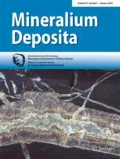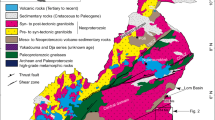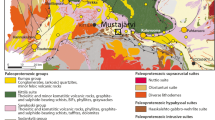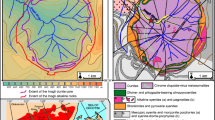Abstract
An under-recognized and economically important class of intrusion-related gold deposits, which occur within magmatic provinces best known for tungsten and/or tin mineralization, is described with reference to seven major deposits (Fort Knox, Mokrsko, Salave, Vasilkovskoe, Timbarra, Kidston and Kori Kollo). These gold deposits contain a metal suite that includes some combination of bismuth, tungsten, arsenic, tin, molybdenum, tellurium and antimony, and contrasts with that found in the more widely-developed gold-rich porphyry copper and related deposits. The gold deposits associated with tungsten and/or tin provinces are located in cratonic margins, in a landward or back-arc position relative to continental margin arcs (where recognized), or within continental collisional settings. The deposits are related genetically to felsic domes, stocks or plutons of intermediate oxidation state, both magnetite- and ilmenite-series magmas are represented. The intrusion-hosted gold deposits are most commonly of sheeted vein/veinlet type, although greisen-like, disseminated and breccia deposits are also described. Gold may also be concentrated more distally (1–3 km) with respect to the intrusions, where deposits may be of skarn, disseminated replacement or vein types. K-feldspar, albite and/or sericitic alteration assemblages, commonly including carbonate, accompany the gold mineralization. In sheeted vein deposits, alteration is normally restricted to narrow envelopes around veins, whereas more pervasive alteration occurs in greisen-like, disseminated and shallow (<3 km) deposits. The gold mineralization is commonly present with low total sulphide contents (<3%), mainly pyrite and lesser arsenopyrite. In several deposits, bismuth minerals are closely associated with gold, and bismuth-gold and tellurium-gold correlations exist. Most deposits contain tungsten, tin, molybdenum and antimony, although generally these do not correlate with gold; tungsten and molybdenum concentrations may increase with depth or may occur in separate zones. Base metals generally are present in minor amounts (e.g. <100 ppm Cu). The distinct spatial association with felsic intrusions, combined with the consistent metal signature, suggests a magmatic-hydrothermal origin. Fluid inclusions studies indicate the presence of high-salinity fluids in some deposits, and low-salinity and carbonic fluids in most deposits, similar to the composition of fluids in intrusion-related tungsten deposits. Variations in mineralization style largely reflect depth of formation and location relative to the intrusive centre. Several deposits in this class contain >100 tonnes (3 million oz) of gold, thereby highlighting the gold potential of intrusion-related deposits beyond the more traditionally explored gold and copper provinces in arc terranes.
Similar content being viewed by others
Author information
Authors and Affiliations
Additional information
Received: 13 March 1998 / Accepted 14 January 1999
Rights and permissions
About this article
Cite this article
Thompson, J., Sillitoe, R., Baker, T. et al. Intrusion-related gold deposits associated with tungsten-tin provinces. Mineral. Deposita 34, 323–334 (1999). https://doi.org/10.1007/s001260050207
Issue Date:
DOI: https://doi.org/10.1007/s001260050207




